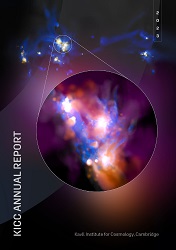Biography
Martin Bourne is a theoretical astrophysicist specializing in the study of supermassive black holes and their influence on galaxy evolution. As of September 2024 Martin holds a UKRI Stephen Hawking Fellowship and is a Senior Lecturer based at the Centre for Astrophysics Research at the University of Hertfordshire. Prior to this, he was a Research Associate at the Kavli Institute for Cosmology and Institute of Astronomy at the University of Cambridge (2015-2020 & 2022-2024). Martin obtained his PhD from the University of Leicester (2012-2015) and completed his undergraduate studies in Physics at the University of Oxford (2006-2010). He additionally has a background in science education having completed a PGCE at the University of Bath (2012) and has industry experience having spent nearly two years working as a software developer.
Research
Martin Bourne's primary research focuses on various aspects of supermassive black hole physics from the event horizon to the cosmic web. He has a particular interest in developing new models and techniques to capture accretion and feedback processes (winds and jets) in both small (e.g. black hole binaries and circumbinary discs) and large-scale (cosmological) simulations in order to understand their impact on galaxy evolution, cosmology and multi-messenger astronomy. Martin is a long-time developer of the Arepo code, and is also a member of several national and international collaborations including the Lisa Consortium (space-based gravitational wave detector), X-Gap (an XMM-Newton project to study hot gas in groups) and the SEEDZ Project (simulation project studying high redshift black hole formation).
Publications
-
Dynamics and spin alignment in massive, gravito-turbulent circumbinary discs around supermassive black hole binaries; M. A. Bourne, D. Fiacconi, D. Sijacki, J. M. Piotrowska & S. Koudmani., Monthly Notices of the Royal Astronomical Society, Volume 534, Issue 4, pp.3448-3477 (2024)
-
A unified accretion disc model for supermassive black holes in galaxy formation simulations: method and implementation; S. Koudmani, R. S. Somerville, D. Sijacki, M. A. Bourne, Y-F. Jiang, K. Profit., Monthly Notices of the Royal Astronomical Society, Volume 532, Issue 1, pp.60-88 (2024)
-
Simulations of spin-driven AGN jets in gas-rich galaxy mergers; R. Y. Talbot, D. Sijacki, M. A. Bourne., Monthly Notices of the Royal Astronomical Society, Volume 528, Issue 3, pp.5432-5451 (2024)
-
Recent Progress in Modeling the Macro- and Micro-Physics of Radio Jet Feedback in Galaxy Clusters; M. A. Bourne & H-Y. K. Yang., Galaxies, Volume 11, Issue 3, id.73 (2023)
-
AGN jet feedback on a moving mesh: gentle cluster heating by weak shocks and lobe disruption; M. A. Bourne & D. Sijacki., Monthly Notices of the Royal Astronomical Society, Volume 506, Issue 1, pp.488-513 (2021)
-
Blandford-Znajek jets in galaxy formation simulations: method and implementation; R. Y. Talbot, M. A. Bourne & D. Sijacki., Monthly Notices of the Royal Astronomical Society, Volume 504, Issue 3, pp.3619-3650 (2021)
-
AGN jet feedback on a moving mesh: lobe energetics and X-ray properties in a realistic cluster environment; M. A. Bourne et al., Monthly Notices of the Royal Astronomical Society, Volume 490, Issue 1, p.343-349 (2019)
-
Fast and energetic AGN-driven outflows in simulated dwarf galaxies; S. Koudmani et al., Monthly Notices of the Royal Astronomical Society, Volume 484, Issue 2, p.2047-2066 (2019)
-
Cold molecular outflows in the local Universe and their feedback effect on galaxies; A. Fluetsch et al., Monthly Notices of the Royal Astronomical Society, Volume 483, Issue 4, p.4586-4614 (2019)
-
AGN jet feedback on a moving mesh: cocoon inflation, gas flows and turbulence; M. A. Bourne & Debora Sijacki, Monthly Notices of the Royal Astronomical Society, Volume 472, Issue 4, p.4707-4735 (2017)
-
Do AGN outflows quench or enhance star formation?; K. Zubovas & M. A. Bourne, Monthly Notices of the Royal Astronomical Society, Volume 468, Issue 4, p.4956-4967 (2017)


